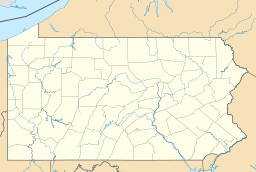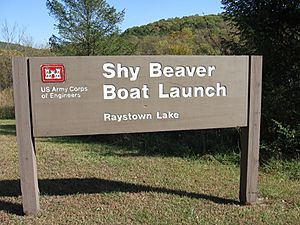Raystown Lake facts for kids
Quick facts for kids Raystown Lake |
|
|---|---|

Raystown Lake Dam
|
|
| Location | Huntingdon County, Pennsylvania, United States |
| Coordinates | 40°26′01″N 78°00′24″W / 40.43361°N 78.00667°W |
| Primary inflows | Raystown Branch Juniata River |
| Basin countries | United States |
| Max. length | 28 mi (45 km) |
| Surface area | 8,300 acres (33.6 km2) |
| Max. depth | 200 ft (61.0 m) |
Raystown Lake is a huge reservoir (which is like a big, artificial lake) located in Huntingdon County, Pennsylvania. It's special because it's the largest lake completely inside Pennsylvania! The lake you see today was finished in 1973 by the Army Corps of Engineers. It's about 200 feet (61 meters) deep in its deepest part, near the dam.
This amazing lake was created for three main reasons. First, it helps control floods, protecting towns downstream. Second, it generates electricity for homes and businesses. Third, it provides lots of fun activities for people to enjoy! A company called Allegheny Electric Cooperative runs the power plant at the Raystown Dam.
Fun Activities at Raystown Lake
Raystown Lake is a super popular spot for outdoor fun. You can enjoy many activities here.
Water Sports and Camping
Many people love to go boating, swimming, and scuba diving in the lake. Fishing is also a big hit! There are lots of campsites around the lake where you can stay. You'll also find places to launch your boat, restaurants, and hiking trails.
During special holidays, like Memorial Day Weekend, July 3rd, and the Sunday before Labor Day, you can even watch amazing firework shows. These fireworks are usually seen from the lake or from the Pennsylvania Route 994 bridge.
Exploring the Natural Beauty
A lot of the land around Raystown Lake is owned by the Army Corps of Engineers. This means it's kept natural and undeveloped. Because of this, the lake feels very wild and beautiful. The hills are covered with trees right down to the water, making it a unique place to explore.
Fishing at Raystown Lake
If you love to fish, Raystown Lake is a great place to cast your line. The lake is home to many different kinds of fish. You can find largemouth bass, striped bass, smallmouth bass, and muskellunge. Other fish include walleye, pickerel, perch, lake trout, rainbow trout, and catfish.
History of Raystown Lake
The story of Raystown Lake involves two different dams built over many years.
The First Raystown Dam
The idea for the first Raystown Dam came about in 1905. Two men, George Ernest and Warren Brown Simpson, were fishing and thought it would be a perfect spot for a hydroelectric project. This means using water to create electricity. They quickly got permission to build it.
Construction of this first dam started in 1907 and finished in 1912. It was a private project, meaning it was funded by a company, not the government. Italian immigrants even helped build the dam by hand and with horses. This dam also led to many cottages being built nearby. Over time, this first dam was bought by different companies and eventually became part of Pennsylvania Electric Company (Penelec) in 1946. Today, this old dam is a popular spot for scuba divers!
The Second Raystown Dam
The idea for the current, much larger Raystown Dam came from a need to control floods, boost tourism, and offer more recreation. Even though tourism was a big part of the plan, the main reason the government approved the new dam was for flood control. It was authorized under the Flood Control Act of 1962.
Stopping Floods
The new dam was designed to hold back a lot of water. This helps reduce flooding in towns along the Juniata River, like Mount Union and Lewistown. It also helps protect areas along the Susquehanna River. For example, during Tropical Storm Agnes in 1972, the partially built dam helped prevent millions of dollars in damages by storing floodwaters.
Planning for Fun
Planners wanted to create a huge lake for summer water sports and outdoor activities. They planned for an 8,300-acre lake that would be about 30 miles (48 kilometers) long with 110 miles (177 kilometers) of shoreline. They expected about 1.4 million visitors each year!
Two main recreation areas were planned: Seven Points Marina and Rothrock camping area. Seven Points Marina was designed for public use, with camping, boat launching, and swimming areas. Rothrock camping area also offered camping, a boat ramp, and showers.
Generating Power Again
Using the new dam for hydroelectric power was important, just like with the first dam. However, building the power plant for the new dam was a bit tricky. It was a public project this time, so many people had ideas about how it should be built.
Finally, in 1980, two companies, Allegheny Electric Cooperative and Penelec, worked together to propose a new power station. This station would use water flowing over the dam to spin turbines and create electricity. The William F. Matson Generating Station was officially opened in 1988. It can generate 21 megawatts of power, enough for about 8,500 homes!
Building the Dam
Construction on the new dam started in 1968 and it began operating in 1973. Building the dam meant that some old landmarks in Huntingdon County were covered by the new lake. This included the old Raystown Dam, Fink's Bridge, and parts of the town of Aitch. Some roads, a bridge, the original power station, and the first dam are still under the water today.
Challenges and Concerns
Building the new dam wasn't without its challenges. Some people worried about the cost, especially during the Vietnam War. They felt the government should focus on war efforts, not recreational projects. There was also a debate about whether the dam was truly for flood control or mostly for recreation. Despite these concerns, the dam project was approved for a total cost of $67.8 million.
Another big issue was the amount of land needed. The government had to buy about 30,000 acres (12,141 hectares) of land. This meant that 1,800 property owners sold their land, and 407 graves had to be moved.
The formal dedication ceremony for Lake Raystown was held on June 6, 1974. Today, the area attracts about 1.5 million visitors every year.
Ancient History at Sheep Rock Shelter
Near the Susquehannock Campground, there's an important archaeological site called Sheep Rock Shelter. It was once a wide ledge over the Juniata River, offering shelter to ancient people. Its location helped preserve remains and artifacts.
When it was announced in the 1960s that the lake would be expanded and this area would be flooded, scientists from Juniata College and Pennsylvania State University quickly dug up the site. They found human remains that were as old as 12,000 years! You can even watch a 29-minute film about this discovery called "Discovery at Sheep Rock."
Images for kids





